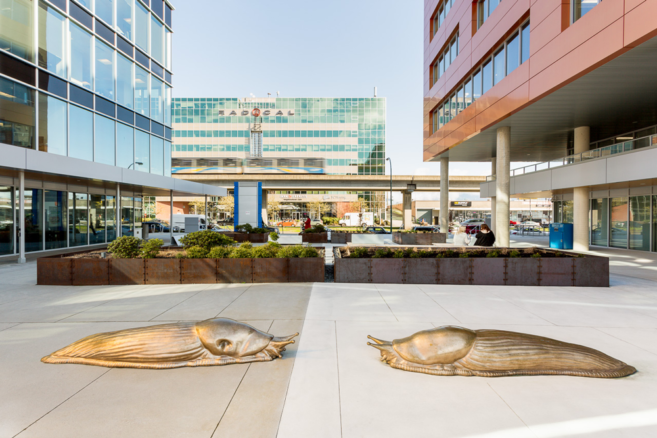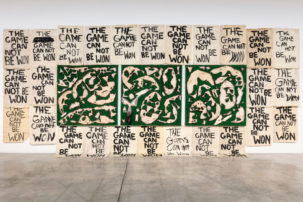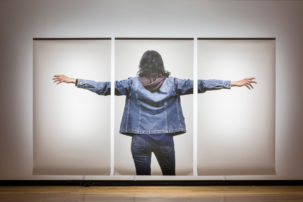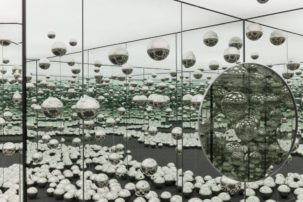Yayoi Kusama at the Art Gallery of Ontario
With online ticket queues making headline news months before the exhibition even opens on March 3, “Yayoi Kusama: Infinity Mirrors” is already pretty much guaranteed to be the blockbuster of this year. The touring survey exhibition (which has already made record-breaking stops at the Hirschhorn Museum in Washington, the Seattle Art Museum and the Broad in Los Angeles) features more than 90 works spanning six decades by the 88-year-old Japanese artist, including the early Infinity Net paintings and surreal, biomorphic Accumulation sculptures marked by her signature polka-dot motif, as well as drawings and rare archival ephemera.
The big draw, though, is a set of six Infinity Mirror Rooms, which Kusama first began producing in the late 1960s. Described as “sculptural, architectural and performative,” these immersive environments are designed to simultaneously expand and collapse perspective in a kaleidoscopic melee of light, surface and reflection. The catch for viewers is that, due to popular demand (just have a look at the selfie phenomenon #infinitymirrors or #infinityrooms), time inside each room is strictly limited to 20 to 30 seconds—the takeaway being, perhaps, that “infinity” does and does not last forever.—Bryne McLaughlin, senior editor
Postcommodity at the Art Gallery of York University
Borders are an equal measure of our strengths and our insecurities. They are both physical barrier and perceptual construct that enforce strategies of violence, intimidation and oppression. Historically and politically determined to claim and enclose space, borders are also perpetually in flux to be challenged, surmounted and destroyed.
American collective Postcommodity (Raven Chacon, Cristóbal Martínez and Kade L. Twist) expand these troubling realities and offer possible subversions in an AGYU exhibition, opening January 11, of three works: A Very Long Line (2016), an immersive, 360-degree video installation that depicts the trans-border diaspora along the border fence that divides Douglas, Arizona, and Agua Prieta, Mexico, and is sited on traditional Indigenous territory; Coyataje (2017), a video and sculptural installation that tracks the complex, cross-cultural dynamics between a militarized border patrol, would-be migrants and the myth of the Chupacabra; and a new audio work designed to mimic and disrupt the sonic subterfuge employed by US border agents to lure people through the landscape.—Bryne McLaughlin, senior editor
The Aboriginal Curatorial Collective National Gathering in Halifax
ACC-CCA is coordinating a large-scale gathering of Indigenous curators, arts administrators and artists of all disciplines from October 10 to 13 in K’jipuktuk/Halifax. As the 2018 edition of the ongoing colloquia and gathering series, this national gathering will explore several themes drawn from interactions across large distances as individual practitioners and on a nation-to-nation basis, including “Through Territories: The Global Indigenous Art Circuit,” “Deepening Connections/Alliances for Interdependent Futures,” and “Respect for Water/Life: For All Relations.” Though the fierce lineup is still under wraps, the ACC-CCA gathering will form new worlds, discourses and networks in Indigenous art globally.—Lindsay Nixon, Indigenous editor-at-large
#callresponse at locations across Canada
#callresponse, the core collective of which is comprised of Tarah Hogue, Maria Hupfield and Tania Willard, is gearing up for its 2018 programming across Canada—already looking to be an epic offering. Since its inception, the collective has endeavoured to support the work of Indigenous women across Turtle Island, seeing their work as a catalyst for conversation, an art grounded in responsible action and community building.
The core artists will stay the same this year, but the reach of the project has expanded greatly, making stops at Blackwood Gallery in Mississauga; AKA, Wanuskewin Heritage Centre and National Indian Media Arts Coalition in Saskatoon; Saint Mary’s University Art Gallery in Halifax; and Stride Gallery and Truck in Calgary. With their eye on the true Indigenous future (not just the rhetorical one), and in conjunction with the Aboriginal Curatorial Collective’s October gathering in partnership with the Nocturne festival, #callresponse will hire an Indigenous curator to program that festival for the first time.—Lindsay Nixon, Indigenous editor-at-large
wnoondwaamin | we hear them at Stride Gallery
Opening in September for its final showing, “wnoondwaamin | we hear them” has been travelling across Canada since 2016, born out of the Sounds Like sound-art festival in Saskatoon. A dream team of artists, Autumn Chacon, Jeneen Frei Njootli, Melissa General and Suzanne Morrisette, uses sound to consider audio vibrations projected by materials and phenomena like antlers, colonial borders, water composition and deep listening. The group also reflects on the relationship between human activity and the land. The opening at Stride is not to be missed, with all artists present, and curator Lisa Myers is organizing an evening of special performances that will surely infect the hyper-masculinist spaces of noise art with Indigenous feminist lifeways.—Lindsay Nixon, Indigenous editor-at-large
Agnes Martin at the Esker Foundation
Agnes Martin is the Prairies’ most famous painter by dint of several years spent in Macklin, Saskatchewan. She spent most of her life in the US after leaving Canada in 1931 at the age of 19, but Canadians still like to claim her in lists and biographical notes. (“Agnes Bernice Martin, born in Canada, was an American abstract painter,” sums up the first line of her Wikipedia entry.) I’ve often wondered what this tells us about nationalism and its relationship to art, but a new show opening in September at the Esker Foundation in Calgary will shed light on the actual substance of Martin’s Canadian connections through a collection of ephemera and source material. Also on view: all 47 of Martin’s prints, which are brought together for the first time.—Caoimhe Morgan-Feir, managing editor
Maureen Gruben at the Libby Leshgold Gallery
This entry might be more accurately described as a show I wish I had seen in 2017. Maureen Gruben made tremendous work last year: virtually none of the art I saw rivalled her Landmarks installation Stitching My Landscape, which involved Gruben feeding red rope through ice-fishing holes around the Ibyuq Pingo, the highest pingo in the Arctic, as if she was mending an open wound. In February, a selection of new work by Gruben, who works in Victoria and Tuktoyaktuk, will go on view in a solo show titled “Qulliq: In Darkness, Light” at Vancouver’s Libby Leshgold Gallery (which was previously the Charles H. Scott Gallery). Gruben will be turning to her childhood in the Arctic for the show, which references a traditional oil lamp used to “to heat, to cook and to bring continuous light during the darkness of the Arctic winter.” No matter the source material, there’s no doubt that Gruben’s singular blend of personal history and environmental consciousness will be on view.—Caoimhe Morgan-Feir, managing editor
Takashi Murakami at the Vancouver Art Gallery
The first solo presentation of Takashi Murakami’s work in Canada kicks off at the Vancouver Art Gallery on February 3, and crowds are to be expected. This world-renowned Japanese artist has been influential, to say the least, and while his show “The Octopus Eats Its Own Leg” has been seen elsewhere already—like the MCA Chicago, where it busted through all attendance records—there will be two new multi-panel paintings created for the Vancouver showing. Beyond that, 55 works spanning three decades will offer plenty to consider.—Leah Sandals, managing editor, online
Nanabozho’s Sisters at the Dalhousie Art Gallery
Curated by Wanda Nanibush in conversation with Peter Dykhuis, “Nanabozho’s Sisters” at the Dalhousie Art Gallery will seek to address the use of humour by Indigenous women artists. Opening in September, the exhibition has a title that refers to Nanabozho, a trickster figure who features as the protagonist of story cycles that are foundational to the Anishinabe origin and belief narratives. The artist list is still firming up, but given vast talent and wit in this sector of the arts, I’m already looking forward to seeing it.—Leah Sandals, managing editor, online
Olivia Boudreau at Galerie d’art Louise-et-Reuben-Cohen
Montreal-based artist Olivia Boudreau has become known in recent years for performance, film and video works that address the female figure and its art-historical treatments in eerie, often mesmerizing ways. In her 2011 video installation Étuve, shown at the Quebec Triennial, women in various states of undress (and various confrontations of the viewer’s gaze) pose in a steam bath, their bodies appearing and disappearing as clouds of water vapour alternately fill up and disperse through the tiled, rectilinear space. Excitingly, new work is on deck for this show, “Scenes and Sequences,” that opens in October as part of the Festival international du cinéma francophone en Acadie—work curated by Penelope Smart that promises to shift into language, psychology and storytelling.—Leah Sandals, managing editor, online
Scott Benesiinaabandan at Paved Arts
Monuments and their deconstruction are one of the potent themes that surface in Newlandia: Fragments from the Future, a series of work opening in May by Montreal-based Obishikokaang Anishinabe artist Scott Benesiinaabandan. Combining photo- and VR-based media, one of the landscapes in this series is composed completely out of images of monuments—namely, the Jacques Cartier monument in St. Henri and the Chomedey-Maisonneuve monument in Old Montreal. While most IRL monuments are made from stone and bronze, Benesiinaabandan’s chopped-up image arrays are dispersed and unstable. It’s a reversal of affect that bodes well for many artists’ continued critiques of colonialism post–#Canada150.—Leah Sandals, managing editor, online
Here We Are Here: Black Canadian Contemporary Art at the Royal Ontario Museum
Opening on January 27, just in time for Black History Month, this exhibition features work by nine Black artists, several of whom have garnered significant attention over the past year. Curators Julie Crooks, Dominique Fontaine and Silvia Forni have selected artists that are a mix of emerging and established, including Sandra Brewster, Michèle Pearson Clarke, Chantal Gibson, Sylvia D. Hamilton, Bushra Junaid, Charmaine Lurch, Esmaa Mohamoud, Dawit L. Petros and Gordon Shadrach. In their statement, the curators explain how “this exhibition defies a singular narrative; it shifts paradigms, and calls attention to its structure as a field of enquiry that encourages us to unlearn and learn more about history, art history and how we curate contemporary art shows in the Canadian context.” Several of these artists have robust, yet underexposed, practices and I’m curious to see what they will bring to the ROM.—Yaniya Lee, associate editor
Kapwani Kiwanga at the Glenhyrst Art Gallery of Brant
I first saw Kapwani Kiwanga’s work at the Power Plant last winter. There, the Paris-based, Ontario-born artist created the installation pink-blue, in which she used light design to explore how constructed environments affect behaviour. For her upcoming show “Clearing” at the Glenhyrst Art Gallery of Brant in Brantford, situated on land traditionally held by Anishinabe and Haudenosaunee peoples, the artist continues her anthropological, research-based art practice—but a little bit closer to home. Kiwanga grew up in Brantford and attended art camps at the gallery as a child, and in this exhibition opening January 10 “she returns to the site of her earliest arts education to consider her experience with the gallery and the region’s unfolding relationship with Indigenous people and the land.”—Yaniya Lee, associate editor
Julian Rosefeldt at the Musée d’art contemporain de Montréal
Having toured the world as a 13-channel installation and as a conventional, single-channel cinematic feature, Julian Rosefeldt’s 2015 work Manifesto will make its Canadian exhibition debut at the Musée d’art contemporain in October. In it, one actor, Cate Blanchett, articulates the writings of such pamphleteers as the Futurists, Dadaists and Supremacists, and she voices the words of other artists such as Yvonne Rainer, Elaine Sturtevant and Jim Jarmusch as well. Staged as individual vignettes in a present-day context, these readings show Blanchett appearing as various characters in monologue, including a teacher delivering a classroom lecture and a news anchor. I’ll be curious to see what happens to the grand pronouncements of the past century and a half of avant-garde Western thought when they’re delivered all at once by a shape-shifting cinematic icon.—Nicholas Brown, manager of programming and contributing editor
Beau Dick at the Audain Art Museum
The year 2017 marked the loss of an iconic artist and leader, Kwakwaka’wakw Northwest Coast carver and hereditary chief Beau Dick. On the eve of Documenta 14, in which a large group of Dick’s masks were set to be exhibited in Athens and later in Kassel, he passed away in BC at the age of 61. Revered for his expertise in traditional Northwest Coast forms and techniques combined with a range of global influences and artistic innovations, Dick’s exceptional life’s work will be celebrated in a retrospective exhibition opening at the Audain Art Museum on March 30, co-curated by his daughter Linnea Dick.—Nicholas Brown, manager of programming and contributing editor
Biennale d’art contemporain autochtone (BACA) at five Montreal-area venues
The fourth edition of the Biennale d’art contemporain autochtone will take over the Montreal area from May 5 to June 16 at five different locations: Art Mûr, La Guilde canadienne des métiers d’art, the McCord Museum, the Stewart Hall Art Gallery in Pointe-Claire and the Musée des beaux-arts de Sherbrooke. New for this year, BACA joins forces with the Aboriginal Curatorial Collective for artistic coordination, and the show will later head over to Ontario’s Art Gallery of Mississauga, a new partnering organization. Although the artist roster is still under wraps, Becca Taylor and Niki Little have been announced as the co-curators. They have selected this year’s theme as being “My Sister,” which will honour how Indigenous sisters share knowledge, hold space and are a source of power for each other—blood-related or not. This major event is not to be missed.—Valérie Frappier, editorial intern
#nofilterneeded: Shining light on the Native Indian/Inuit Photographers’ Association (NIIPA), 1985—1992 at the McMaster Museum of Art
The McMaster Museum of Art starts off 2018 by shedding light on NIIPA, an association that formed in Hamilton circa 1985 and played an important role in supporting Indigenous image-makers during an era where little support was to be had. Curated by Rhéanne Chartrand, and running January 2 to March 24, the project features works that mostly stem from two of NIIPA’s first exhibitions—“Visions” (1985) and “Silver Drum” (1986)—and it will revisit how the organization worked to shatter stereotypes by using photography as a way to assert Indigenous self-representation. Many of the group’s members remain influential artists and arts workers today, and include Shelley Niro, Jolene Rickard, Greg Staats and Jeff Thomas among their ranks.—Valérie Frappier, editorial intern
Naufus Ramirez-Figueroa at SFU Audain Gallery and Plug In ICA
Born in Guatemala City in 1978, migrated to Canada as a child and graduated from Vancouver’s Emily Carr University of Art and Design in 2006, Naufus Ramirez-Figueroa has gone from performing at Toronto’s Pleasure Dome and Edmonton’s Visualeyez to, more recently, attracting international acclaim for performances at New York’s Guggenheim and Venice’s Biennale. This year, his work returns to at least two Canadian venues—the SFU Audain Gallery in Vancouver from February 14 to March 3, where a solo durational performance and new sculptures will be featured, and Plug In ICA in Winnipeg as of March 29, where an installation that premiered recently at the Kunsthalle Lisbon will be on display.—Leah Sandals, managing editor, online
Li Salay at the Art Gallery of Alberta
Where are the peripheries of contemporary Métis art? This is a crucial question posted by “Li Salay,” an exhibition of contemporary Métis art curated by Amy Malbeuf and Jessie Short that is due to run at the Art Gallery of Alberta in Edmonton from May 26 to September 2. The show emerges from intensive, cross-Canada research and studio visits with numerous Métis artists conducted by Malbeuf and Short between 2016 and 2017.—Leah Sandals, managing editor, online
Future Possible at the Rooms
It’s time for the first major publication of Newfoundland and Labrador art history—and a major survey of Newfoundland and Labrador art to match it. “Future Possible” at the Rooms from May 12 to September 3 promises to consider how “artists have shaped the way we view this province’s past, present and future.” Contemporary and historical will be placed in conversation, as well as themes of loss and nostalgia, insider and outsider, and slow and fast time.—Leah Sandals, managing editor, online
This story was corrected on January 11, 2018. The original copy indicated different dates for Naufus Ramirez-Figueroa’s exhibition at the SFU Audain Gallery.

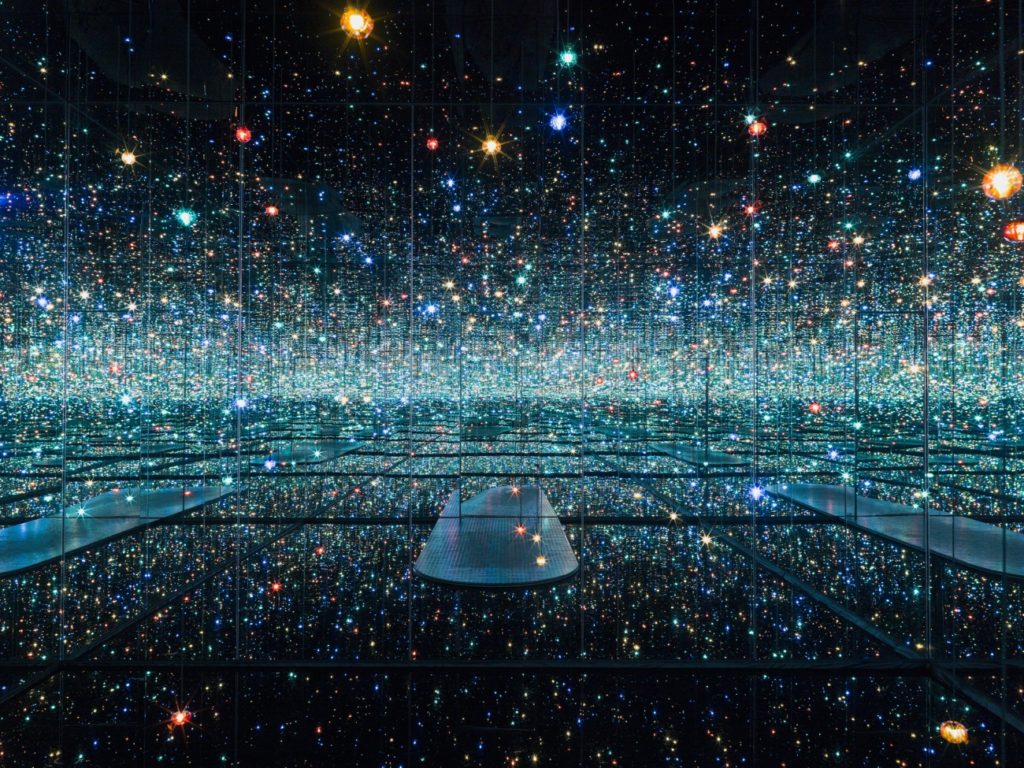 Yayoi Kusama, Infinity Mirrored Room – The Souls of Millions of Light Years Away, 2013. Wood, metal, glass mirrors, plastic, acrylic panel, rubber, LED lighting system, acrylic balls and water, 287.7 × 415.3 × 415.3 cm. Courtesy of David Zwirner, NY © Yayoi Kusama.
Yayoi Kusama, Infinity Mirrored Room – The Souls of Millions of Light Years Away, 2013. Wood, metal, glass mirrors, plastic, acrylic panel, rubber, LED lighting system, acrylic balls and water, 287.7 × 415.3 × 415.3 cm. Courtesy of David Zwirner, NY © Yayoi Kusama.
